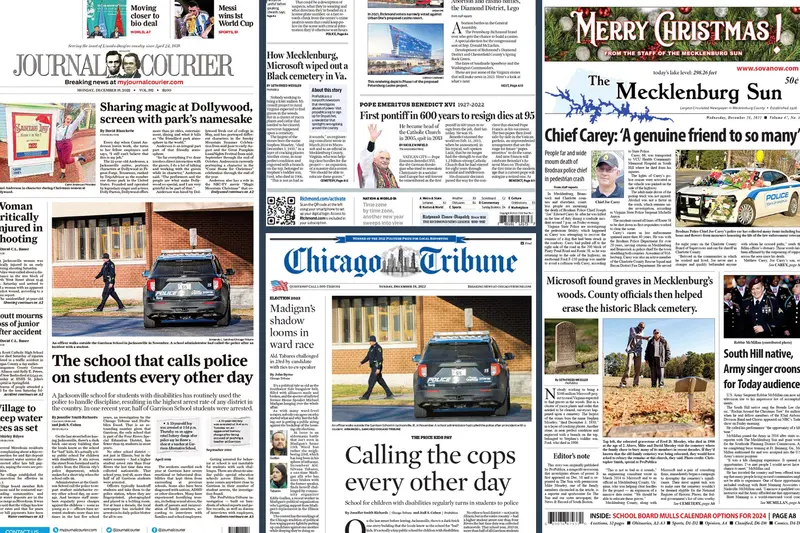10 Easy Facts About News Articles Described
10 Easy Facts About News Articles Described
Blog Article
The smart Trick of News Articles That Nobody is Talking About
Table of Contents8 Easy Facts About News Articles ShownNews Articles Can Be Fun For Everyone10 Easy Facts About News Articles DescribedEverything about News ArticlesThe Single Strategy To Use For News Articles
Excellent knowledge of different subjects gives trainees a competitive side over their peers. Although electronic and social media are readily easily accessible, we need to not neglect exactly how crucial it is to read the papers. Parents have to attempt and inculcate the habit of checking out a paper as an everyday routine to continue the heritage of the adored print tool.News stories also consist of at the very least one of the complying with important features relative to the intended target market: distance, importance, timeliness, human passion, curiosity, or repercussion.
Within these limits, newspaper article also intend to be detailed. Other factors are included, some stylistic and some acquired from the media kind. Among the larger and extra revered papers, fairness and balance is a major consider presenting info. Discourse is typically confined to a different area, though each paper may have a various overall slant.
Newspapers with an international audience, as an example, often tend to utilize a more official style of writing. The certain selections made by an information outlet's editor or editorial board are commonly collected in a style overview; typical style guides consist of the and the United States Information Style Publication. The primary goals of information writing can be summed up by the ABCs of journalism: precision, brevity, and quality.
Fascination About News Articles
As a policy, reporters will not use a long word when a short one will do. Information writers attempt to avoid making use of the very same word more than once in a paragraph (occasionally called an "echo" or "word mirror").
Nonetheless, headings occasionally omit the topic (e.g., "Jumps From Watercraft, Catches in Wheel") or verb (e.g., "Pet cat female lucky"). A subhead (likewise subhed, sub-headline, subheading, caption, deck or dek) can be either a subservient title under the major headline, or the heading of a subsection of the short article. It is a heading that precedes the primary text, or a group of paragraphs of the main text.

Added signboards of any of these kinds may show up later in the post (particularly on succeeding web pages) to tempt additional analysis. Such billboards are additionally made use of as pointers to the post in other sections of the magazine or website, or as promotions for the item in various other publication or sites. Regular structure with title, lead paragraph (recap in bold), various other paragraphs (information) and contact information.

Instance of a hard-lead paragraph NASA is suggesting one more room task. The agency's budget plan demand, announced today, included a strategy to send one more goal to the Moon. This time around the company wishes to establish a long-lasting facility as a jumping-off place for various other room experiences. The budget requests around $10 billion for the task.
The NASA news came as the agency asked for $10 billion of appropriations for the project. An "off-lead" is the 2nd crucial front web page information of the day. The off-lead shows up either in the leading left edge, or directly below the lead on the. To "bury the lead" is to start the post with background info or information of secondary relevance to the visitors, requiring them to find out more deeply into a post than they must have to in order to uncover the necessary factors.
News Articles - An Overview
Usual use is that a person or 2 sentences each create their own paragraph. Journalists normally describe the company or structure of a news site here tale as an upside down pyramid. The vital and most intriguing elements of a story are put at the beginning, with sustaining info following in order of reducing value.
It enables people to explore a topic to just the depth that their inquisitiveness takes them, and without the imposition of information or nuances that they could think about pointless, yet still making that details offered to a lot more interested viewers. The upside down pyramid structure likewise enables articles to be trimmed to any kind of arbitrary size during design, to fit in the room available.
Some writers start their stories with the "1-2-3 lead", yet there are lots of kinds of lead available. A twist can refer to multiple points: The last tale in the news program; a "pleased" tale to end the program.
Longer short articles, such as publication cover articles and the items that lead the inside areas of a paper, are understood as. Attribute stories differ from straight news in numerous means. Foremost is the lack of a straight-news lead, many of the time. As opposed to offering the essence find of a story up front, attribute writers may attempt to lure readers in.
Not known Incorrect Statements About News Articles
A function's very first paragraphs often connect a fascinating minute or event, as in an "anecdotal lead". From the particulars of a person or episode, its view rapidly widens to generalizations concerning the story's topic.
The Editor's Toolbox: A Recommendation Overview for Beginners and Professionals (2001) Allan M. Siegal and William G. Connolly. The New York Times Guidebook of Style and check here Use: The Official Style Overview Utilized by the Writers and Editors of the Globe's Many Authoritative Newspaper (2002) M. L. Stein, Susan Paterno, and R.
Report this page